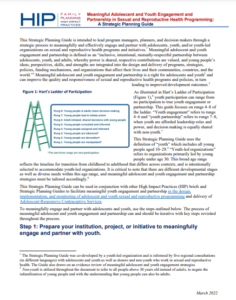
This Strategic Planning Guide is intended to lead program managers, planners, and decision makers through a strategic process to meaningfully and effectively engage and partner with adolescents, youth, and/or youth-led organizations on sexual and reproductive health programs and initiatives.* Meaningful adolescent and youth engagement and partnership is defined as an “inclusive, intentional, mutually-respectful partnership between adolescents, youth, and adults, whereby power is shared, respective contributions are valued, and young people’s ideas, perspectives, skills, and strengths are integrated into the design and delivery of programs, strategies, policies, funding mechanisms, and organizations that affect their lives and their communities, countries, and the world.”1 Meaningful adolescent and youth engagement and partnership is a right for adolescents and youth2 and can improve the quality and responsiveness of sexual and reproductive health programs and policies, in turn leading to improved development outcomes.3
As illustrated in Hart’s Ladder of Participation (Figure 1),4 youth participation can range from no participation to true youth engagement or partnership. This guide focuses on rungs 4–8 of the ladder. “Youth engagement” refers to rungs 4–6 and “youth partnership” refers to rungs 7–8, when youth are afforded leadership roles and power, and decision making is equally shared with non-youth.**
This Strategic Planning Guide uses the definition of “youth” which includes all young people aged 10–29.5 “Youth-led organizations” refers to organizations primarily led by young people under age 30. This broad age range reflects the timeline for transition from childhood to adulthood that differs across contexts, and is intentionally selected to accommodate youth-led organizations. It is critical to note that there are different developmental stages as well as diverse needs within this age range, and meaningful adolescent and youth engagement and partnership strategies must be tailored accordingly.6
This Strategic Planning Guide can be used in conjunction with other High Impact Practices (HIP) briefs and Strategic Planning Guides to facilitate meaningful youth engagement and partnership in the design, implementation, and monitoring of adolescent and youth sexual and reproductive programming and delivery of Adolescent-Responsive Contraceptive Services.
To meaningfully engage and partner with adolescents and youth, use the steps outlined below. The process of meaningful adolescent and youth engagement and partnership can and should be iterative with key steps revisited throughout the process.
*The Strategic Planning Guide was co-developed by a youth-led organization and is informed by five regional consultations (in different languages) with adolescents and youth as well as donors and non-youth who work in sexual and reproductive health. The Guide also draws on an evidence review of meaningful adolescent and youth engagement strategies.
**Non-youth is utilized throughout the document to refer to all people above 30 years old instead of adults, to negate the infantilization of young people and with the understanding that young people can also be adults.
References
- Family Planning 2020; International Youth Alliance for Family Planning; Partnership for Maternal, Newborn & Child Health (PMNCH), et al. Global Consensus Statement on Meaningful Adolescent and Youth Engagement. PMNCH; 2018. Accessed February 23, 2022. https://www.who.int/pmnch/mye-statement.pdf
- United Nations. Office of the High Commissioner for Human Rights (OHCHR). Convention on the Rights of the Child. United Nations Treaty Series, 1577, 3. OHCHR; 1989. https://www.ohchr.org/en/professionalinterest/pages/crc.aspx
- Patton GC, Sawyer SM, Santelli JS, et al. Our future: a Lancet commission on adolescent health and wellbeing. Lancet. 2016;387(10036):2423–2478. https://doi.org/10.1016/S0140-6736(16)00579-1
- Hart RA. Children’s Participation: From Tokenism to Citizenship. Innocenti Essay No. 4. International Child Development Centre; 1992. Accessed February 23, 2022. https://www.unicef-irc.org/publications/100-childrens-participation-from-tokenism-to-citizenship.html
- United States Agency for International Development (USAID). Youth in Development Policy: Realizing the Demographic Opportunity. USAID; 2012. Accessed February 23, 2022. https://www.usaid.gov/policy/youth
- Catino J, Battistini E, Babchek A. Young People Advancing Sexual and Reproductive Health: Toward a New Normal. Youth Investment, Engagement, and Leadership Development (YIELD) Project; 2019. Accessed February 23, 2022. https://www.summitfdn.org/wp-content/uploads/2018/11/YIELD_full-report_June-2019.pdf
- French M, Bhattacharya S, Olenik C. Youth Engagement in Development: Effective Approaches and Action-Oriented Recommendations for the Field. USAID; 2014. Accessed February 23, 2022. https://pdf.usaid.gov/pdf_docs/PA00JP6S.pdf